Are you a Quiet Speculation member?
If not, now is a perfect time to join up! Our powerful tools, breaking-news analysis, and exclusive Discord channel will make sure you stay up to date and ahead of the curve.
Last month, Patrick Chapin went 8-1 on Day 1 of GP Oklahoma with Temur Prowess, and the deck hasn’t been talked about much since. I find this very odd, since The Innovator's decks usually see much press and emulation. Not so this time. I thought this was odd enough that my video series this week was about exploring the deck. After playing it extensively, I am even more confused.
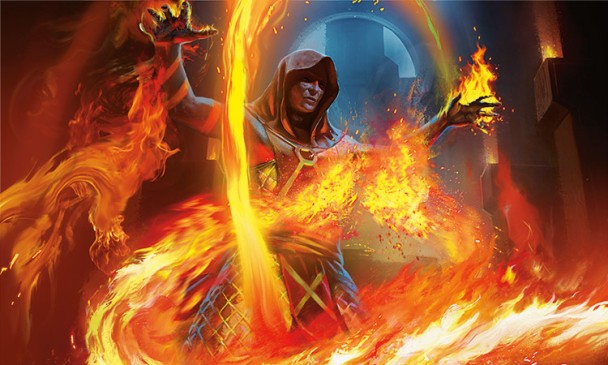
Tempo in Modern exists in this strange state where the incentives to support the strategy are all in place, but the strategy as a whole is kept down by the threefold enemies of discard, cheap removal, and inconsistency. Grixis Delver has been the de facto “Tempo Deck” in Modern for a while, but suffers primarily from inconsistent Delver flips and too much incidental life loss against aggro strategies. I think that Temur Prowess is the deck to change that. Were we in the Modern PPTQ season, this deck would be everywhere, but currently, it’s flying under the radar. Modern is about to experience a cataclysm. Death shall come on swift wings. Fish meat is basically a vegetable.
[wp_ad_camp_1]
Temur Prowess in Context
Currently, when players think of tempo in Modern they think of Grixis Delver, which enjoys success largely due to the adoption of Kolaghan's Command and Tasigur, the Golden Fang.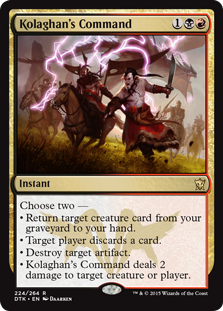 Exactly how "tempo" Grixis actually is a matter for debate but the fact is that everyone believes it is tempo. Those familiar with the deck will speak of the power of Kolaghan's Command alongside Snapcaster Mage to provide both resiliency against discard and the ability to re-buy creatures against removal in the mid and lategame. Delve creatures like Tasigur, the Golden Fang fit naturally alongside cheap, interactive spells that fill the graveyard quickly, and grant the archetype a Tarmogoyf-sized frame in a color other than green for equal (often cheaper) mana investment. Tasigur’s sizing lines up positively with Delver of Secrets, punishing opponents relying on cheap, damage-based removal to answer Delver at parity before Remand can be a factor. All of these elements (and more) combine to grant Grixis Delver excellent matchups against all forms of Twin, control, and most combo.
Exactly how "tempo" Grixis actually is a matter for debate but the fact is that everyone believes it is tempo. Those familiar with the deck will speak of the power of Kolaghan's Command alongside Snapcaster Mage to provide both resiliency against discard and the ability to re-buy creatures against removal in the mid and lategame. Delve creatures like Tasigur, the Golden Fang fit naturally alongside cheap, interactive spells that fill the graveyard quickly, and grant the archetype a Tarmogoyf-sized frame in a color other than green for equal (often cheaper) mana investment. Tasigur’s sizing lines up positively with Delver of Secrets, punishing opponents relying on cheap, damage-based removal to answer Delver at parity before Remand can be a factor. All of these elements (and more) combine to grant Grixis Delver excellent matchups against all forms of Twin, control, and most combo.
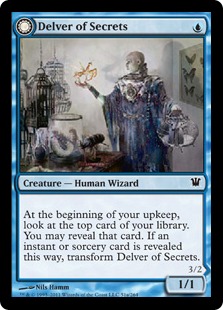 For all its strengths, Grixis Delver struggles in a few areas. Heavy mana requirements lead to substantial incidental damage from lands over the course of a game, severely hurting the Burn and Affinity matchup. If Jund can draw its Lightning Bolts or pick apart a shaky hand with Thoughtseize/Liliana of the Veil, that matchup can also be a nightmare. Delver of Secrets/Young Pyromancer line up poorly against Pyroclasm vs. Tron, and that matchup can vary wildly depending on how many counterspells we draw. On top of all of that, Delvers can sometimes not flip, though this only happens when I’m playing the deck, and never when playing against it!
For all its strengths, Grixis Delver struggles in a few areas. Heavy mana requirements lead to substantial incidental damage from lands over the course of a game, severely hurting the Burn and Affinity matchup. If Jund can draw its Lightning Bolts or pick apart a shaky hand with Thoughtseize/Liliana of the Veil, that matchup can also be a nightmare. Delver of Secrets/Young Pyromancer line up poorly against Pyroclasm vs. Tron, and that matchup can vary wildly depending on how many counterspells we draw. On top of all of that, Delvers can sometimes not flip, though this only happens when I’m playing the deck, and never when playing against it!
Keeping this in mind, let’s take another look at Temur Prowess and see what it offers through the lens of what we’re searching for. Playing a new deck is fun, and there’s value in bringing something unknown to the table, but the goal here is to avoid playing a “bad Delver deck”. Let’s get to it!
"Temur Prowess, Patrick Chapin (64th GP Oklahoma City 2015)"
Deck Discussion
For those interested in a general overview and discussion of this deck, check out my latest video article here.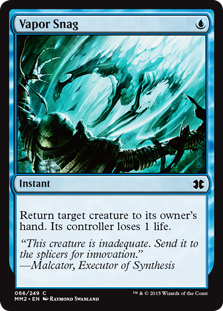 As it currently exists, this version of Temur Prowess looks to take advantage of cheap but powerful creatures in the same way as Grixis Delver, capitalizing on that advantage with tempo-generating spells like Vapor Snag and Remand. In exchange for built-in resiliency to discard from Kolaghan's Command and Tasigur, the Golden Fang we gain consistency and a smoother manabase against aggressive strategies. Without having to spend precious early mana Thought Scour’ing to set up Tasigur, the Golden Fang, we can just drop a Tarmogoyf and push our mana-efficiency to the maximum. Abbot of Keral Keep and Snapcaster Mage with Vapor Snag generate more of whatever effect we need, giving us some play in the mid- to late-game. Our early creatures put the opponent on the back foot consistently and work to keep them there. From my experience, our Jund matchup is worse compared to Grixis Delver's, while our matchups against Burn and Affinity (and any other deck looking to race) are all significantly better.
As it currently exists, this version of Temur Prowess looks to take advantage of cheap but powerful creatures in the same way as Grixis Delver, capitalizing on that advantage with tempo-generating spells like Vapor Snag and Remand. In exchange for built-in resiliency to discard from Kolaghan's Command and Tasigur, the Golden Fang we gain consistency and a smoother manabase against aggressive strategies. Without having to spend precious early mana Thought Scour’ing to set up Tasigur, the Golden Fang, we can just drop a Tarmogoyf and push our mana-efficiency to the maximum. Abbot of Keral Keep and Snapcaster Mage with Vapor Snag generate more of whatever effect we need, giving us some play in the mid- to late-game. Our early creatures put the opponent on the back foot consistently and work to keep them there. From my experience, our Jund matchup is worse compared to Grixis Delver's, while our matchups against Burn and Affinity (and any other deck looking to race) are all significantly better.
Since recording the video series, I’ve played a bunch of matches with the deck, and have picked up a few interesting points:
- We might be slightly creature light. With 17 creatures (though Grim Lavamancer really doesn’t count) we can get draws where we only have one or two creatures, and a couple discard/removal spells later we can be spinning our tires. We have no Delver of Secrets or Young Pyromancer to discourage us from playing more creatures, and while Snapcaster/prowess guys appreciate a bunch of noncreature spells I think attacking with a creature every turn is more important.
- Abbot of Keral Keep/Snapcaster Mage
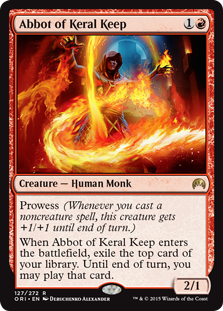 in combination with Vapor Snag gives us a lot of resiliency going late. Normally tempo strategies like this are at the mercy of their land to spell ratio, and drawing too much air can “spell” doom (see what I did there?). I’ve found that we have a strong infrastructure in place in the form of these three cards that work to gain double and even triple value out of some spells.
in combination with Vapor Snag gives us a lot of resiliency going late. Normally tempo strategies like this are at the mercy of their land to spell ratio, and drawing too much air can “spell” doom (see what I did there?). I’ve found that we have a strong infrastructure in place in the form of these three cards that work to gain double and even triple value out of some spells.
- Having a one drop isn’t necessary, but definitely makes winning a lot easier. Currently we have Monastery Swiftspear and Serum Visions as turn one plays, and games where we can drop Swiftspear early and start racking up damage feel a lot more manageable for us. While we can drop a 6/7 Tarmogoyf and bash for two turns, we normally win with “chip shot damage” (getting points in here and there). Starting this process on turn one is a goal I’d like to work towards accomplishing more consistently if possible.
The Singleton Question
Seal of Fire has its strengths, but can be underwhelming when we’re searching for a consistent board presence. Usually, if we have some creatures on the field we’re ahead, which makes these spells a little “win-more”. If all Seal of Fire is doing is growing our Tarmogoyf, is it really necessary? I know it’s another Lightning Bolt that we can flip off Abbot and hold to kill a creature later, but do we even want a Shock? What if Seal of Fire was a creature instead? Every non-creature spell we cut makes our prowess guys a tiny bit worse, but again, my problems with this deck come when Jund grinds me out of creatures, or I draw a hand full of reactive elements and no way to apply pressure.
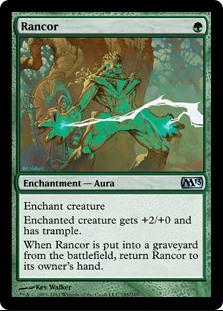 Moving further down this line, Rancor usually acts as another Shock that threatens repeat damage and lets our Tarmogoyf punch through Lingering Souls tokens and opposing Tarmogoyfs/Rhinos/Tasigurs. I’m much more hesitant to cut this one, as its floor is usually Lava Spike and its ceiling is incredible. I have yet to face Lingering Souls online, but if I ever run into it, this is the exact card I would want in the matchup.
Moving further down this line, Rancor usually acts as another Shock that threatens repeat damage and lets our Tarmogoyf punch through Lingering Souls tokens and opposing Tarmogoyfs/Rhinos/Tasigurs. I’m much more hesitant to cut this one, as its floor is usually Lava Spike and its ceiling is incredible. I have yet to face Lingering Souls online, but if I ever run into it, this is the exact card I would want in the matchup.
Maybe Izzet Charm is good, but I’ve been unimpressed. It exists as an all-purpose spell to maybe counter something, maybe kill something, or maybe help a bad hand upgrade into something manageable. I’ve found that I’m not happy doing any of these though, and every time I draw Izzet Charm I’m frantically searching to use it in some way that doesn’t feel horrible. Even the ceiling on this card (discarding two lands to hopefully draw two spells) is underwhelming, as we end up down a card and two mana in the process. I’d much rather exchange this for another business spell that does something on its own and rely on Abbot/Snapcaster to give me more action going late.
The Case for Goblin Guide
While it is strictly worse in this deck than Monastery Swiftspear (which goes to show how busted Monastery Swiftspear is) Goblin Guide might be exactly what we need.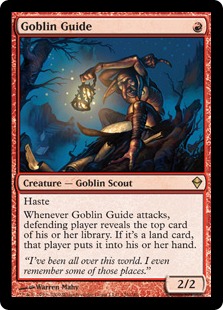 The maindeck is pretty tight and we can’t change many slots (unless we’re looking to give up on Mishra's Bauble) but I think Goblin Guide can work towards what we were discussing earlier: starting games with a haste creature hitting on turn one consistently. If Goblin Guide can hit twice we’re significantly ahead, and we don’t necessarily care about giving our opponent’s free lands as we were putting ourselves behind on cards but ahead on tempo already with Vapor Snag. In addition, while Goblin Guide is a one-drop he essentially gives us more turn two plays, as we can go Guide into Swiftspear/Visions on turn two to set up Abbot of Keral Keep + free spell on turn three. The goal here is not to flood the board per se, but rather to provide a certain relevant board presence that can take advantage of Vapor Snag and Remand keeping the opponent on the back foot.
The maindeck is pretty tight and we can’t change many slots (unless we’re looking to give up on Mishra's Bauble) but I think Goblin Guide can work towards what we were discussing earlier: starting games with a haste creature hitting on turn one consistently. If Goblin Guide can hit twice we’re significantly ahead, and we don’t necessarily care about giving our opponent’s free lands as we were putting ourselves behind on cards but ahead on tempo already with Vapor Snag. In addition, while Goblin Guide is a one-drop he essentially gives us more turn two plays, as we can go Guide into Swiftspear/Visions on turn two to set up Abbot of Keral Keep + free spell on turn three. The goal here is not to flood the board per se, but rather to provide a certain relevant board presence that can take advantage of Vapor Snag and Remand keeping the opponent on the back foot.
Other Options
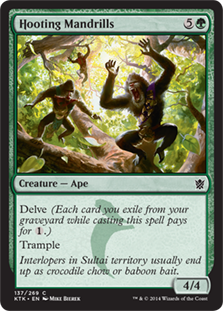 Some commentators on Pat’s original article last month were discussing the inclusion of Hooting Mandrills, as currently we are casting eight free spells with no way to take advantage of our plump graveyard early. This discussion has merit, as delve really is a busted mechanic, but there is a certain tension between wanting to take advantage of our graveyard and wanting to leave it alone for Tarmogoyf and Grim Lavamancer. On top of that, I’m not sure Hooting Mandrills is the answer, as a 4/4 is pretty unimpressive against opposing x/5’s (including opposing Tarmogoyfs, which are difficult for this deck to handle). Hooting Mandrills has been described as a “worse Tarmogoyf”, which I can understand, but that doesn’t really apply as Tarmogoyf is pretty busted. Casting a 4/4 trample creature for one or two mana shouldn’t feel bad because you could have had a 6/7 for two. We’re already playing four Goyf, so that shouldn’t even be a part of the conversation. I’m more interested in what the spell can actually provide our strategy, and right now I don’t think he’s what we’re after.
Some commentators on Pat’s original article last month were discussing the inclusion of Hooting Mandrills, as currently we are casting eight free spells with no way to take advantage of our plump graveyard early. This discussion has merit, as delve really is a busted mechanic, but there is a certain tension between wanting to take advantage of our graveyard and wanting to leave it alone for Tarmogoyf and Grim Lavamancer. On top of that, I’m not sure Hooting Mandrills is the answer, as a 4/4 is pretty unimpressive against opposing x/5’s (including opposing Tarmogoyfs, which are difficult for this deck to handle). Hooting Mandrills has been described as a “worse Tarmogoyf”, which I can understand, but that doesn’t really apply as Tarmogoyf is pretty busted. Casting a 4/4 trample creature for one or two mana shouldn’t feel bad because you could have had a 6/7 for two. We’re already playing four Goyf, so that shouldn’t even be a part of the conversation. I’m more interested in what the spell can actually provide our strategy, and right now I don’t think he’s what we’re after.
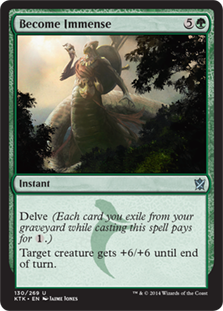 Become Immense, on the other hand, could be exactly what we are looking for. Often speeding up our clock by a full turn or more, Become Immense can take advantage of our graveyard in a big way. Acting as a huge source of burst damage, Become Immense can either end the game quickly or push our opponent into Lightning Bolt range. Again, I’m hesitant to add another spell that doesn’t do much on its own, but I think our deck can use one delve spell and Become Immense might just be good enough.
Become Immense, on the other hand, could be exactly what we are looking for. Often speeding up our clock by a full turn or more, Become Immense can take advantage of our graveyard in a big way. Acting as a huge source of burst damage, Become Immense can either end the game quickly or push our opponent into Lightning Bolt range. Again, I’m hesitant to add another spell that doesn’t do much on its own, but I think our deck can use one delve spell and Become Immense might just be good enough.
Other than that, there’s not much else about the maindeck I would change. The fourth Snapcaster Mage can sometimes feel like one too many, but the card is extremely powerful and three feels like too few. 18 lands can sometimes feel like too many, but we don’t necessarily mind hitting four lands thanks to Abbot of Keral Keep and Snapcaster flashing back Remand. Post-board, I haven’t been upset to hit five land once we bring in Dispels. I’m almost wondering if we want to play 61 cards. It might actually be right, as we’re really looking for 3.5 Snapcaster Mages and 17.5 lands. It’s possible that a little down the line we want to push the delve theme a little more, with Thought Scour to support it, and maybe then we might want the 61st card (as an extra bullet is fine to mill over with Thought Scour so Snapcaster can grab it). For now, I think we’ll leave the manabase the same.
Sideboard
Before we actually move onto the sideboard, this is what I’m thinking for the maindeck (spells only)
Maindeck
Small changes, for sure, but really this is because I think Chapin's list was already pretty close. Besides, adding Goblin Guide could be horrible (I don’t think it is, but it could be) and we don’t want to make drastic changes to the base. With Goblin Guide and Become Immense as the only differences, we’ll be able to tell quickly whether the list is running better with these changes or not. Moving on to the sideboard, I’ve been pretty happy with most of these cards and wouldn’t change them:
Sideboard
Our Burn matchup seems really solid, and we might not even need the Feed the Clan, but I don’t want to skimp against Burn if I don’t have to. Burn has a way of punishing stumbles, and I'd like to have some insurance for when I inevitably stumble too. I’d rather be confident in the matchup, but if we’re really sure, the Feed the Clan could become a fourth Dispel and we wouldn’t lose too many points against Burn.
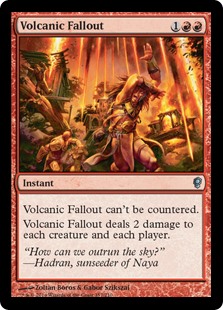 Volcanic Fallout is great against Affinity, Elves and Abzan Company, and even did work against Geist of Saint Traft in one match. Our delve guys live through it (Swiftspear by itself, Abbot needs a little help) which makes it a one-sided sweeper most of the time. Izzet Staticaster is excellent against Affinity, Infect, and Lingering Souls, and can even combine with Volcanic Fallout to actually kill a solid board against Merfolk.
Volcanic Fallout is great against Affinity, Elves and Abzan Company, and even did work against Geist of Saint Traft in one match. Our delve guys live through it (Swiftspear by itself, Abbot needs a little help) which makes it a one-sided sweeper most of the time. Izzet Staticaster is excellent against Affinity, Infect, and Lingering Souls, and can even combine with Volcanic Fallout to actually kill a solid board against Merfolk.
Sometimes we need a few hard counters, and Deprive is great against Scapeshift, Twin, and basically any strategy where we’re looking to slow down a little bit post-board. Normally we get to run the tables game one, but once people wise up to our Vapor Snags and start trying to interact with us using removal I like having some more general answers.
The Jund matchup seems tough, but I don’t know what we can really do to help it. More creatures seems to be a good plan, so the Goblin Guides should do a little work, but I expect the matchup to still be an uphill battle. Kitchen Finks is an absolute beating and I definitely want some Pillar of Flames if that card becomes more widely played (as it should, because Kitchen Finks is still incredible). Maybe we could try and go a little bigger with a Huntmaster of the Fells or something? It seems suspect with 18 lands, but I haven’t had trouble hitting four lands that often and it’s a solid threat that lives through Liliana of the Veil, dodges Inquisition of Kozilek, looks reasonable against Terminate, and can be used in other slow matchups if necessary. It could definitely be anything else, but until I can find a good “anti-Jund card” I want to try it out.
"Temur Prowess Evolved - Trevor Holmes"
This is where I'm at currently with the list. I like Goblin Guide so far and feel like it gives me more consistently good draws while raising my floor, at the cost of a slightly lower ceiling. We won't be hitting with a 6/7 Tarmogoyf that often, but the trade-off has been positive so far and I'm excited to keep working on this deck further. What do you think? Let me know in the comments if you've picked up the deck yourself, or if you have any suggestions or opinions. As always, feel free to stop by my Twitch stream at twitch.tv/Architect_Gaming if you want to see this deck in action! Thanks for reading and I'll see you next week!
Trevor Holmes
The_Architect on MTGO
twitch.tv/Architect_Gaming
twitter.com/7he4rchitect





Saw that deck at GP Oklahoma and am eager to see more of that since I like tempo decks in general and was somewhat hyped about that one.
Thanks for another article about this great deck. I’ve been looking for a tempo deck in Modern since UR Delver got the axe and nothing scratched the itch until Chapin handed us this beauty. After playing the deck for a few weeks I agree with you that it feels a bit threat light; the games where we don’t have a turn 1 Swiftspear or at least a Serum Visions feel a lot worse due to our lack of velocity before our opponent gains a board presence.
I also toyed with the idea of one Become Immense but so far have been trying a second Rancor to good results. I’m happy to see the card almost every time I draw it, and with your addition of 2 Goblin Guides I feel like it would be even better.
I also cut the Copperline Gorge and went to 17 lands as Chapin mentioned that he often felt like he had too many in the deck. I think if you’re more willing to keep mystery hands full of Baubles and Probes having one less land feels pretty good.
Izzet charm has been extremely lackluster for me and I think it’s an easy swap. I’m still unsure on Seal of Fire however, it helps in a number of situations just by sitting on the board making things awkward for opponents. I might cut the maindeck Seal and keep the sideboard copy.
Having played Jordan Boisvert’s Monkey Grow list for a bit I don’t think Huntmaster is where you want to be with 17/18 lands. It can be rather difficult to cast and I often feel like I’d have rather spent the 4 mana doing something more productive.
I actually toyed with the idea of a 1 or 2 of Atarka’s Command in the main, have you tried it at all in testing?
I like the changes you made. I ve played grixis delver for a while and this seems to be a Nice Tempo Alternative Rather than a “Bad delver” deck.
One question. Did you thought of atarkas Command? Since it can result in some Sweet Turns with all the prowes we have
Let me know your thoughts on this one.
Greez
I am curious, would you actually consider playing spreading seas in the deck? Infect and other super fast decks I see do utilize it from time to time. To my mind, it will improve the Tron match up as well as the Jund match up. Furthermore, it boosts Abbot and you’re able to fill your hand up with another relevant cheap spell to potentially play again.
I think your original decklist is incorrect for Patrick Chapin’s Temur Prowess deck from GP Oklahoma, the original looked like this:
-1 Snapcaster
-1 Grim Lavamancer
+1 Rancor
+1 Izzet Charm
SB:
-1 Negate
+1 Feed the Clan
source from the deck tech vod: http://www.twitch.tv/magic2/v/15695467?t=2h39m23s
Some of these changes went in rather unexpected directions in my opinion, but I think you’re onto something with the pump angle. If that turns out to be successful, do you think you’ll stick with “big pump” in Become Immense, or will you consider Mutagenic Growth for its excellent synergy with Monastery Swiftspear? I’m getting the feeling that the combination of the two could be quite good.
Simic Charm has been used to great effect as a 1x in Temur Delver lists. It seems like it could be even better here.